Kenneth C. Davis's Blog, page 95
June 12, 2013
Who Said It? 6-12-3
President George Herbert Walker Bush “Address Before a Joint Session of Congress on the End of the Gulf War” (March 6, 1991)
Now, we can see a new world coming into view. A world in which there is the very real prospect of a new world order. In the words of Winston Churchill, a world order in which “the principles of justice and fair play protect the weak against the strong. . . .” A world where the United Nations, freed from cold war stalemate, is poised to fulfill the historic vision of its founders. A world in which freedom and respect for human rights find a home among all nations. The Gulf war put this new world to its first test. And my fellow Americans, we passed that test.
Source: Miller Center: The American President
George Herbert Walker Bush was born on June 12, 1924 in Milton, Massachusetts. You can read more about him and his presidency in Don’t Know Much About® the American Presidents.
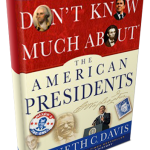
June 5, 2013
Who Said It? 6/2/13
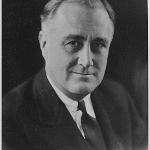
President Franklin D. Roosevelt, “D-Day Prayer” (June 6, 1944)
With Thy blessing, we shall prevail over the unholy forces of our enemy. Help us to conquer the apostles of greed and racial arrogancies. Lead us to the saving of our country, and with our sister Nations into a world unity that will spell a sure peace a peace invulnerable to the schemings of unworthy men. And a peace that will let all of men live in freedom, reaping the just rewards of their honest toil.
(Source: Franklin D. Roosevelt: “Prayer on D-Day,” June 6, 1944. Online by Gerhard Peters and John T. Woolley, The American Presidency Project. http://www.presidency.ucsb.edu/ws/?pi.... 
On the night of June 6, 1944, President Roosevelt went on national radio to discuss the invasion of Normandy –D-Day– with the American people. His address took the form of this prayer. (Full text from Franklin D. Roosevelt Presidential Library and Museum)
May 29, 2013
Don’t Know Much About® JFK
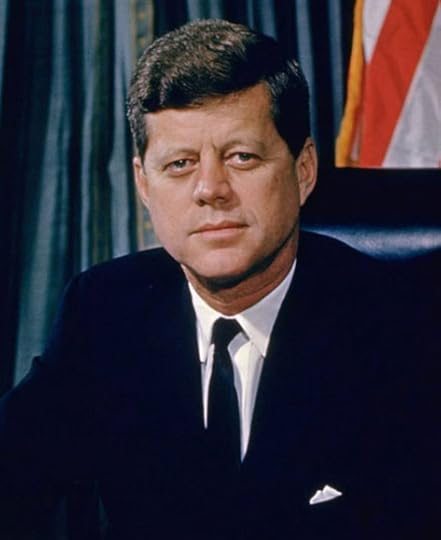
President John F. Kennedy (1961)
(Photo by Alfred Eisenstadt-Courtesy of White House Press Office)
Frozen in time as the youthful avatar of a new generation in American politics, John F. Kennedy would have been 96 years old today. He was born on May 29, 1917.
Now, more than 50 years after John F. Kennedy was inaugurated, the public remains fascinated with the man, his family, and his times. His life and loves, his controversial death, and the legacy of his brief presidency and extended family continue to exert a hold on the American imagination.
When JFK was assassinated on November 22, 1963, the modern myth-making machine was set in motion. It transformed a president who had committed serious mistakes while also conjuring brilliant successes into a sun- dappled, all- American legend— a modern young King Arthur from Camelot, the popular musical of the day, which became the enduring image of his abbreviated life and presidency.
Elected at forty-two—still the youngest elected president— and dead at forty-six, John F. Kennedy had, in the lyrics of Camelot, a “brief, shining moment” that remains one of the most extraordinary passages in American history, shaping the course of modern presidential politics and history. From the Bay of Pigs fiasco to the near-disaster of the Cuban Missile Crisis and America’s growing involvement in Vietnam, all set against the American civil rights crusade, the glow of Kennedy’s legacy as president has been dulled by time. Yet he remains beloved by many Americans.
✱ Kennedy was the first president born in the twentieth century.
✱ He was the first, and to date, only Roman Catholic to be elected president.
✱ To date, Kennedy is the only president to win a Pulitzer Prize, for Profiles in Courage. Before his death in 2008, former Kennedy speechwriter Theodore Sorensen confirmed that he had written the book with Kennedy.
✱ Kennedy was the first president to have a poet take part in his inaugural. Robert Frost recited from memory an older poem, “The Gift Outright,”
✱ While there had been gardens at the White House since the time of John Adams, and presidents such as Jefferson and John Quincy Adams had been enthusiastic gardeners, the iconic “Rose Garden,” outside the president’s office, was formalized by Kennedy. After his 1961 trip to Europe, Kennedy wanted a more formal setting for official use.
✱ John F. Kennedy and William Taft are the only presidents buried at Arlington National Cemetery.
Following his death, this obituary appeared in the New York Times.
The John F. Kennedy Presidential Library and Museum is in Boston.
You can read more about John F. Kennedy and his presidency in Don’t Know Much About® the American Presidents and Don’t Know Much About® History 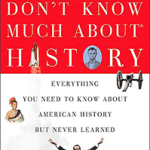

May 28, 2013
Don’t Know Much About Geography-Revised and Updated Edition
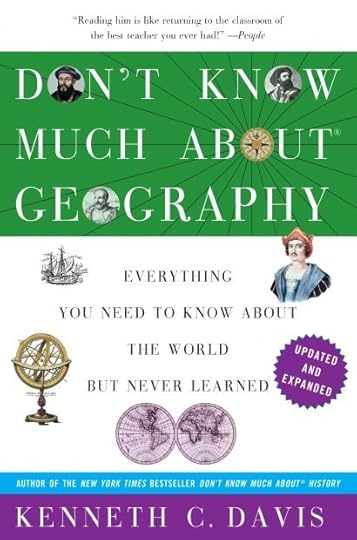
Don’t Know Much About® Geography
Revised & Updated
Now available in a revised and updated edition: DON’T KNOW MUCH ABOUT® GEOGRAPHY: Everything You Need to Know About the World but Never Learned
by KENNETH C. DAVIS
•Who killed the Dead Sea?
•Why did Columbus think the world was shaped like a pear?
•Does the World Bank have ATMs?
•Is all the talk of global warming just a lot of hot air?
In a world of Google maps, “checking in,”and smartphones that tell us where we are, does Geography still matter?
Of course! Because Geography is more than simply knowing where you are and memorizing state capitals.
Understanding geography is to understand that WHERE something happens has so much to do with WHY it happens. Geography is about looking at the world and asking questions. It is the reason humanity moved from one place to the next and eventually off the planet in search of new worlds.
Geography is about curiosity — Where am I? What’s on the other side of that mountain? How do I get from here to there? And what and who will I find there?
Geography is also about the way people “discovered” the world. And, as usual, the real story is a lot more interesting than the simplistic version we got in grade school. Remember they told you that Columbus proved the world was round?
Wrong. People knew that the world was spherical by the time Columbus sailed in 1492. But Columbus actually thought the world was shaped like a pear. That’s what he wrote in his logbooks when he saw a river that he thought might even be one of the biblical rivers that flowed around the Garden of Eden. They left that out of my schoolbooks. (He also wrote that the world was shaped like a woman’s breast. But that’s another story!)
Even as technology shrinks time and distance, thinking “geographically” –looking at the world with wonder and asking Why?– is the key to understanding the things that make us all different. Technology may shorten distances, but the differences remain. If we ever hope to completely bridge those distances and honor those differences, we’re going to have lo learn the lessons of Geography.
Enjoy the journey!
Who Said It 5-28-13
President Andrew Jackson, “First Annual Message” (“State of the Union”) December 18, 1829
Our conduct toward these people is deeply interesting to our national character. Their present condition, contrasted with what they once were, makes a most powerful appeal to our sympathies. Our ancestors found them the uncontrolled possessors of these vast regions. By persuasion and force they have been made to retire from river to river and from mountain to mountain, until some of the tribes have become extinct and others have left but remnants to preserve for a while their once terrible names. Surrounded by the whites with their arts of civilization, which by destroying the resources of the savage doom him to weakness and decay, the fate of the Mohegan, the Narragansett, and the Delaware is fast over-taking the Choctaw, the Cherokee, and the Creek. That this fate surely awaits them if they remain within the limits of the States does not admit of a doubt. Humanity and national honor demand that every effort should be made to avert so great a calamity. It is too late to inquire whether it was just in the United States to include them and their territory within the bounds of new States, whose limits they could control. That step can not be retraced. A State can not be dismembered by Congress or restricted in the exercise of her constitutional power. But the people of those States and of every State, actuated by feelings of justice and a regard for our national honor, submit to you the interesting question whether something can not be done, consistently with the rights of the States, to preserve this much- injured race.
As a means of effecting this end I suggest for your consideration the propriety of setting apart an ample district west of the Mississippi, and without the limits of any State or Territory now formed, to be guaranteed to the Indian tribes as long as they shall occupy it, each tribe having a distinct control over the portion designated for its use. There they may be secured in the enjoyment of governments of their own choice, subject to no other control from the United States than such as may be necessary to preserve peace on the frontier and between the several tribes. There the benevolent may endeavor to teach them the arts of civilization, and, by promoting union and harmony among them, to raise up an interesting commonwealth, destined to perpetuate the race and to attest the humanity and justice of this Government.
On May 28, 1830, Andrew Jackson signed the Indian Removal Act.
Under Jackson, and his successor Martin Van Buren, the so-called “Civilized Tribes” living east of the Mississippi were removed from their lands, including those who were forced to march West on the “Trail of Tears.”
Citation: Andrew Jackson: “First Annual Message,” December 8, 1829. Online by Gerhard Peters and John T. Woolley, The American Presidency Project. http://www.presidency.ucsb.edu/ws/?pi....
May 20, 2013
Who said it- 5/20/13
President Abraham Lincoln: “Message to Special Session of Congress”
July 4, 1861
This is essentially a people’s contest. On the side of the Union it is a struggle for maintaining in the world that form and substance of government whose leading object is to elevate the condition of men; to lift artificial weights from all shoulders; to clear the paths of laudable pursuit for all; to afford all an unfettered start and a fair chance in the race of life. Yielding to partial and temporary departures, from necessity, this is the leading object of the Government for whose existence we contend.
Source: Abraham Lincoln, “Special Session Message, July 4, 1861,” in A Compilation of the Messages and Papers of the Presidents, vol. 7, ed. James D. Richardson (New York: Bureau of National Literature, 1897), pp. 3227-29, 3231-32.
Internet Modern History Sourcebook- Fordham University
On May 20, 1862, the Homestead Act was signed into law. It provided the “fair chance in the race of life” for millions of settlers.
Read more at the National Park Service Homestead National Monument site.
The text of the Homestead Act can be found in the National Archives site.
Read more about Lincoln in Don’t Know Much About the American Preidents, Don’t Know Much About History,, and Don’t Know Much About the Civil War.
[image error]
Don’t Know Much About the American Presidents
(September 18, 2012-Hyperion Books)
May 13, 2013
Who Said It 5/13
James K. Polk “Proclamation 47 – Announcement That a State of War Exists With the Republic of Mexico” May 13, 1846
Whereas the Congress of the United States, by virtue of the constitutional authority vested in them, have declared by their act bearing date this day that “by the act of the Republic of Mexico a state of war exists between that Government and the United States:”
Now, therefore, I, James K. Polk, President of the United States of America, do hereby proclaim the same to all whom it may concern; and I do specially enjoin on all persons holding offices, civil or military, under the authority of the United States that they be vigilant and zealous in discharging the duties respectively incident thereto; and I do, moreover, exhort all the good people of the United States, as they love their country, as they feel the wrongs which have forced on them the last resort of injured nations, and as they consult the best means, under the blessing of Divine Providence, of abridging its calamities, that they exert themselves in preserving order, in promoting concord, in maintaining the authority and the efficacy of the laws, and in supporting and invigorating all the measures which may be adopted by the constituted authorities for obtaining a speedy, a just, and an honorable peace.
In testimony whereof I have hereunto set my hand and caused the seal of the United States to be affixed to these presents.
Done at the city of Washington, the 13th day of May, A. D. 1846, and of the Independence of the United States the seventieth.
JAMES K. POLK.
(Source: The American Presidency Project: James K. Polk: “Proclamation 47 – Announcement That a State of War Exists With the Republic of Mexico,” May 13, 1846. Online by Gerhard Peters and John T. Woolley, The American Presidency Project. http://www.presidency.ucsb.edu/ws/?pi....
May 11, 2013
The “New Classics”?

A “Classic,” as Mark Twain memorably defined it, is “a book which people praise but don’t read.”
Twain’s definition came to mind when I recently came across a “Recommended Reading List for College Bound Students” posted by the National Endowment for the Humanities on its Edsitement website.
The list includes many worthy titles from the fields of government, mythology, philosophy and religion, along with fiction, poetry and drama.
The fiction list ranges (alphabetically) from the late Chinua Achebe down to Eudora Welty. And yes, Mr. Clemens –Mark Twain—is on it.
The complete list is filled with noteworthy names, titles and significant documents that should be familiar to any well-read, educated person –particularly those who want to audition for Jeopardy. They all belong in the so-called “Canon” or “Great Books.” And I am sure that Edsitement doesn’t mean to suggest that this is ALL you need to read.
But…. It is also a list that could have been published when I graduated from high school in 1972 –the modern Dark Ages. While most of the fiction titles still deserve to be there, the most recent novel on the list is One Hundred Years of Solitude, published in 1967.
Similarly, in the nonfiction area the most recent titles include Profiles in Courage and The Autobiography of Malcolm X. And in the Mythology category, I will respectfully call Edith Hamilton’s Mythology “dated.”
So, teachers of Social Studies and English, here is the question: What are the “new classics?”
What books written during the past 50 years do you assign or recommend for Social Studies? Or English classes? What books written since 2000 do you include on your personal “Recommended Reading List for College Bound Students?”
In the fiction category, there is a dearth of black, Native American, Latino, and overseas voices. To begin with, I might suggest Alice Walker (The Color Purple), Salman Rushdie’s Midnight’s Children, and Louise Erdrich (Love Medicine, Beet Queen).
When it comes to nonfiction, the possibilities are endless. How about more recent titles on race, class, the digital world and the contemporary American experience? How about Barbara Ehrenreich’s Nickel and Dimed? Fast Food Nation? Is Barack Obama’s Dreams from My Father as significant a book today as John F. Kennedy’s Profiles in Courage was in the 1960s?
I could go on. But I am more interested in what you are doing in class. Let the #sschat conversation begin.
May 8, 2013
Don’t Know Much About Harry S. Truman
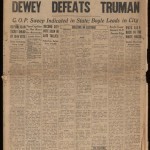
The famed headline from the Presidential election of 1948 when Truman came from behind to grab victory (Photo courtesy of Library of Congress-American Memory)
I graded him an “A” in Don’t Know Much About the American Presidents. But America was not always so generous towards Harry S. Truman, America’s 33rd President, born on May 8, 1884 in Lamar, Missouri.
Truman inherited the Oval Office on April 12, 1945 after First Lady Eleanor Roosevelt told him that President Franklin D. Roosevelt was dead. The following day, a shaken Truman said to reporters:
Boys, if you ever pray, pray for me now. I don’t know whether you fellows had a load of hay fall on you, but when they told me yesterday what had happened, I felt like the moon, the stars, and all the planets had fallen on me.
The only president with combat experience in World War I, Truman was a relatively obscure Senator from Missouri who had been picked to fill out Roosevelt’s ticket for the unprecedented and successful fourth run at the presidency in 1944. As FDR’s fourth term opened, the war in Europe was nearing its conclusion but the brutal and deadly fighting in the Pacific continued –with a potential invasion of Japan on the horizon.
With the overwhelming task of replacing the dominant political figure of the 20th century, Truman was immediately faced with a daunting choice: whether or not to use the atomic bomb– a weapon Truman did not know existed until he became president. The fateful decision to drop the bombs on Hiroshima and Nagasaki in August 1945 remains his most controversial action.
In FDR’s unfinished term and his own term, that followed a come-from-behind victory in 1948, Truman would make other controversial and unpopular decisions about war and peace that were all part of his “The Buck Stops Here”* legacy:
•desegregating the armed forces
•recognizing Israel’s statehood
•”containing” Communism as the Cold War heated up
•entering the war in Korea
•firing the popular General Douglas MacArthur
•setting in motion the “Marshall Plan” to rebuild war-torn Europe
When he left office in 1953, his popularity was in shreds. But Truman’s common sense, honesty, and decisiveness have left “Give “em Hell” Harry with a much better historical legacy. Truman died on December 26, 1972. (His New York Times obituary.)
Read more about Truman in Don’t Know Much About the American Presidents.

*”The Buck Stops Here” was the famed saying on a plaque that Truman kept on his Oval Office desk.
May 7, 2013
Who Said It 5/7
President Harry S. Truman, announcing the surrender of Nazi Germany (May 8, 1945)
THIS IS a solemn but a glorious hour. I only wish that Franklin D. Roosevelt had lived to
witness this day. General Eisenhower informs me that the forces of Germany have surrendered
to the United Nations. The flags of freedom fly over all Europe.
For this victory, we join in offering our thanks to the Providence which has guided and sustained
us through the dark days of adversity.
Our rejoicing is sobered and subdued by a supreme consciousness of the terrible price we have
paid to rid the world of Hitler and his evil band. Let us not forget, my fellow Americans, the
sorrow and the heartache which today abide in the homes of so many of our
neighbors-neighbors whose most priceless possession has been rendered as a sacrifice to
redeem our liberty.
(Source: Harry S. Truman Library and Museum
Read more about Truman and World War II in Don’t Know Much About History and Don’t Know Much About the American Presidents.[image error]



